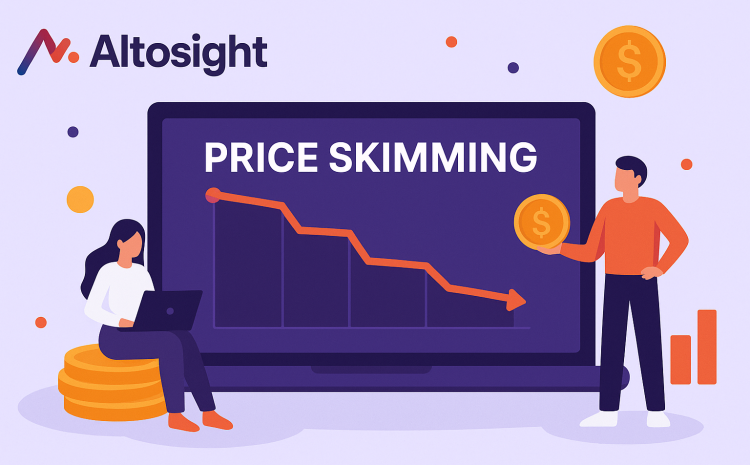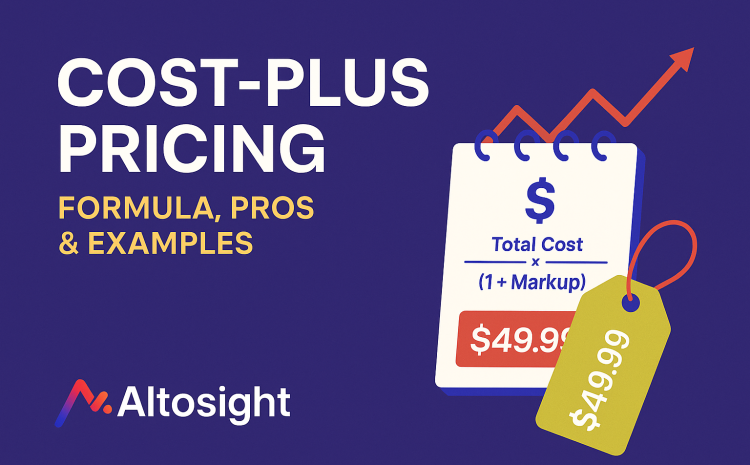
For any business to thrive, it must be able to attract customers, deliver value, and remain profitable.
One crucial part of achieving these goals is to set the right price.
Price influences purchase behavior, especially in highly competitive markets where consumers have an abundance of choices.
So how can a retailer know how to price their products?
By studying and adapting to the competition.
With competitive pricing, retailers gain a competitive edge by avoiding the trial-and-error process associated with setting different price points.
In this article, we’ll look at competitive pricing examples, understand this strategy’s advantages and disadvantages, and learn how to do competitor pricing analysis the correct way.
What Is Competitive Pricing?
Competitive pricing is when retailers align their product prices to those of their competitors. In some cases, such as Original Equipment Manufacturer (OEM) or private label products competitive pricing takes into account prices of similar products. This is most often the case with Amazon and other marketplaces.
For example, let’s say retailer A wants to determine the price of a coffee machine. They notice their competitor sells the same product with the same features for $99. So, they set a similar price.
This strategy is also known as market-oriented pricing as retailers follow the market price, sometimes without considering their costs and goals.
This tactic works best when multiple retailers sell the same product and allows a business to set a competitive price with minimal effort. If you follow this strategy ideally you should be able to buy with low wholesale prices, so you can afford more competitive prices.
Competitive pricing affects consumers in different ways. For example, two brands selling paper will likely compete on price since there is little room to stand out.
However, vendors in the electronics industry can compete on quality and price as customers are willing to pay above the market rate for products from an established brand or those with better features.
This means there is an opportunity for experimentation.
Most consumers are price-sensitive when they perceive the value of two products to be the same.
Competitive pricing can also be used as a basis from which prices are adjusted up or down based on the retailer’s goal and the market’s ongoing price changes.
A Few Competitive Pricing Examples
The most common businesses where Competitive Pricing is hugely important and impactful are Supermarkets.
As we all know, most of them carry many of the same products, so they have to compete on prices and consumers are price-sensitive in these purchases.
Another major industry where competitive pricing is rampant is Telecommunication. Phone carriers fight tooth and nail for new customers.
These are some very obvious examples, but others include ecommerce stores and online retailers. If a person wants to buy a product from Amazon or a direct e-Retailer, they are more than likely to compare prices or visit a price comparison site before they make a purchase.
You don’t necessarily have to be the cheapest, but you must be price competitive.
Let’s see another example from the manufacturer’s point of view:
Let’s say that car manufacturer A is about to release a new SUV.
They decide to engage in competitive pricing and compare the features of their car with similar SUVs from manufacturers B and C.
After this research, they might realize that their SUV provides fewer or more features than their nearest competitors, so they might want to increase or decrease their Manufacturer’s Suggested Retail Price (MSRP).
Or they might package and present their offering differently with more optional upgrades.
More often than not competitive pricing is mixed and matched with other pricing strategies.
What Are The Pros & Cons Of Competitive Pricing?
Competitive pricing isn’t the only pricing strategy available to retailers.
Alternative options include Demand-Based Pricing, Price Skimming, Cost-Plus Pricing, Psychological Pricing, Keystone Pricing and more.
So, when does it make sense to use competitive pricing and what are its limitations?
Advantages
- Simple to use
Unlike other strategies, competitive pricing is easy to use.
All that a retailer has to do is figure out who their competitors are and track their prices which are often publicly displayed.
While this can be difficult to do manually, competitor price monitoring tools can speed up this process, especially when multiple competitors are involved.
- Low-risk
Businesses might make mistakes in the price calculation and update processes due to a lack of experience, knowledge, or human error.
By studying the competition, retailers can forgo the cost of figuring out the market equilibrium price as it’s unlikely that multiple competitors who have invested in due diligence will have gotten the price wrong.
However, it’s always highly recommended whether you are using software or change your prices manually to set a minimum price per product, so you avoid selling at a loss.
A minimum price formula can be for example:
Minimum price = Wholesale Price + % Margin + VAT (if applicable)
- Increase sales and market share
The market is not stationary. It responds to fluctuations in demand and prices.
Attentive retailers can maximize their sales and profit by monitoring these changes and fine-tuning their prices. Also, they can have some Loss Leaders which serve to bring in more clients and increase your customer base, in order to upsell them later more products.
Minimum Advertised Price (MAP) policies of some manufacturers may limit your ability to be highly competitive, but you can prioritize manufacturers with no MAP policy or run limited time promo campaigns with the backing of the manufacturers.
Disadvantages
- Hard to stand out
When multiple retailers sell the same product at the same price, it can be difficult to stand out.
What is the benefit of buying from one retailer versus another if they have the same prices?
Thus, under competitive pricing, retailers have to find other ways to be unique, such as offering extra perks, exceptional service, or creating a brand story customers can relate to. Creating brand equity and trust can be a significant factor to be preferred, even at higher prices.
- Can lead to a price war
Competitive pricing creates an environment of undercutting which can lead to a race to the bottom.
When one retailer charges less than the competitive price, it disrupts the equilibrium price and invites others to do the same.
If too many retailers start undercutting each other each hour it can lead to tedious pricing wars which can reduce everyone’s profit margins and make it harder to increase prices later.
- No room for error correction
There will be times when competitors make mistakes in calculating optimal prices.
Thus, blindly copying the competitive price without doing your competitive analysis means you’ll make the same mistake and miss the opportunity to outperform the market by setting the right price.
For example, there are cases where a retailer might incorrectly sell products below the wholesale price. This is a recipe for disaster and you can avoid it by using the minimum prices mentioned earlier.
Always take into account your own strategy and profitability.
How To Perform Competitive Pricing?
Before deciding on their prices, retailers should perform a competitive pricing analysis to understand the market.
This process evaluates how consumers react to new prices by studying historical data. The insights from this process will reveal the various competitive price points to sell at.
However, if you don’t use software and you want to avoid dedicating so much time to it, you can just go to a marketplace or a price comparison website, check that day’s prices and adjust accordingly.
From here, retailers can narrow down the ideal price.
- Define the competition
A retailer should be able to name three to five direct competitors.
This is important because aligning prices with any competitor might or might not work.
For example, a hardware store might price its repair kit at $99, similar to a national chain. However, it may not realize that its competitor includes a five-year warranty at that price and multiple retail stores, as well as brand equity and trust.
Here are a few questions a retailer can ask to narrow down the competition:
- What is the geographical area of your competition?
- What products/markets are your competitors operating in?
- How long have your competitors been in business?
- What online review score do they have?
- Are they profitable? If so, what is their profit percentage? (optional if you can narrow it down)
- Figure out your total costs
To earn a profit, the sale price must be higher than the associated costs.
How are costs defined in this context?
Retailers need to pay attention to both implicit and explicit costs.
Implicit costs are not initially obvious. For example, the number of hours a business spends on a promotional campaign is an implicit cost as they could have invested this time elsewhere.
On the other hand, explicit costs such as the cost to acquire and store products, salaries, rent etc are easy to measure.
Retailers must consider both costs when deciding on a final price.
If the competitive price does not cover your costs, this strategy will not work.
- Identify the best price and measure results
To do this, businesses need to understand their target market.
Here are two questions to consider:
- Retailers should determine how price-sensitive the market is. For example, if competitors change their price, does it impact your sales volume?
- If you’re a wholesaler, at what price point does sales volume stabilize? If a business can sell 100 units at $150 and 100 units at $200, selling at a higher price is more profitable.
Keeping an eye on sales activity allows a business to stay agile as it can adjust prices to meet goals.
Types Of Competition-Based Pricing
When engaging in competitive pricing, a business has three options to set the sale price.
Does it want to gain market share? Create a high-end brand image? Or does it want a piece of the pie?
The answer to these questions will determine what competitive pricing strategy it should use.
For example, when attempting to gain market share, a retailer might undercut the competitive price.
Let’s look at these three different options:
- Prestige or Premium Pricing
Prestige or Premium Pricing is when a business sets a price above the competition.
This tactic only works if a business is an established brand that consumers trust more and believe will provide high-quality products, support and overall experience. Only in such cases, consumers are prepared to pay a premium.
- Loss Leaders
This pricing strategy is popular among retailers.
In the Loss Leader model, a retailer sells products below the competitive price, with very low profit margins and in some cases even at a loss.
A retailer might do this to increase its customer base and boost the sales of other products it sells through upsells and cross-sells.
Effectively, a retailer subsidizes sales in the short term for long-term gain.
- Price Matching
Under Price Matching, retailers set prices to match the competition. This reduces both profit and risk.
This is a good approach when a retailer enters an oversaturated market with little opportunity to differentiate.
To stand out in this environment, retailers have to be creative. For example, they might offer a small gift, or a loyalty program or invest in a different marketing strategy to stand out.
Conclusion
Being able to set the right price at the right time can deliver significant results to any business.
Competitive pricing is one of the best methods to determine the best price for your products and service. To succeed, retailers must track what competitors are doing and test different prices.
Doing so gives retailers complete control over their position in the market.





